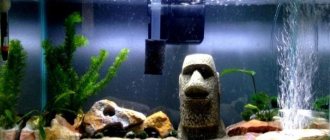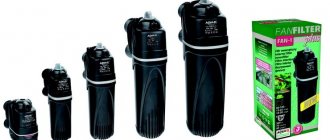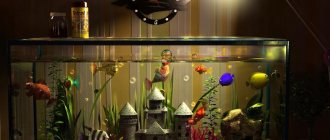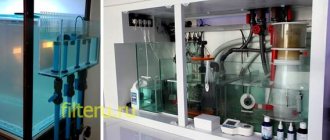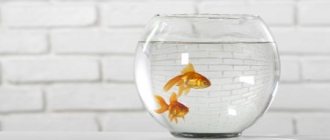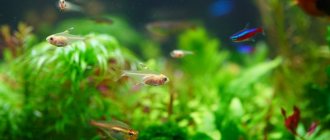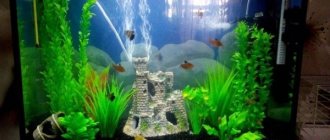The filter in an aquarium is the most important piece of equipment, a life support system for your fish, removing toxic waste, chemicals, and if working correctly, saturating the water in the aquarium with oxygen. For the filter to work properly, it needs beneficial bacteria to grow inside it, and improper care kills them, resulting in problems with the balance. Unfortunately, most filters lack simple and clear instructions for the user to understand them.
Rules and best ways to clean the filter in an aquarium
What determines the frequency of maintenance of an aquarium filter?
It is common for novice aquarists to make mistakes in their pond care schedule. Rare cleaning, as well as too frequent cleaning, is harmful to the aqua system and can cause problems. Factors influencing the frequency of aquarium maintenance:
- Aquarium volume. Ponds that are too small need to be cleaned more often than large ones, because in large aquariums the aquatic system is more stable.
- Number of living fish. The more inhabitants there are, the more often you will have to clean it. By adding more feed, waste increases.
- Number of natural plants. Living plants serve as a biological filter for the aquatic system. They are involved in processing waste, absorbing harmful substances, and cleaning the reservoir.
- Bacteria. This is the basis of biological filtration. They are engaged in primary waste processing. Their action affects the stability of the aquatic system.
- Filtration. The filter is selected according to the volume of the aquarium. The installed mechanism must be able to cope with the volume of waste and create a sufficient level of water circulation. The frequency of treatment of the aquarium filter depends on how the filtration is performed.
- Feeding. The reservoir is also polluted due to overfeeding of fish. Feeding is best done in moderation.
- Failure to maintain the correct aquarium maintenance regime. Due to excessive lighting, walls and decorations become dirty, and problems with algae appear. Excessive application of fertilizers leads to this effect.
For continuous filtration, a constant flow of oxygen is required to the filter material. Interruptions in the supply of oxygen, which is dissolved in water, can occur due to two circumstances:
- If the filter material is not cleaned from mechanical contamination in a timely manner. Excess dirt interferes with the flow of oxygen and saprophytes (plant organisms that feed on dead organic matter) do not decompose organic matter as they should.
- Interruptions in the functioning of the aquarium filter. If there is no oxygen supply, beneficial bacteria will die off. Due to prolonged stoppages in the operation of the filter, colonies of microorganisms will die. Such a situation will lead to reverse processes in the filter, and the dead saprophytes will begin to release toxic substances into the water: hydrogen sulfide, methane, ammonia and carbon dioxide. If a filter that does not work for a long time is connected, streams of contaminants with an unpleasant odor will flow into the water, poisoning the inhabitants of the aquarium.
Signs of dirty filter elements
Filter models are different and devices for small aquariums need to be cleaned more often than those for large ones. When determining contamination, you need to take a closer look at the water flow from the device. If the flow becomes weaker, then this is a sign that flushing is required. If the water in the reservoir becomes cloudy, this also serves as a signal that the filter is dirty.
How to properly clean filters?
It is important that these devices work efficiently, saturating the aquarium water with oxygen. Despite the differences in brands and power, the filtration devices are similar. For this reason, both internal and external filters are cleaned according to the above example. There are two types of cleaning aquarium filters:
- cleaning filter elements;
- complete cleaning (filter elements and mechanical ones are cleaned).
Filter elements are cleaned regularly as they become dirty. Complete cleaning is recommended when microorganisms with other deposits interfere with the normal functioning of the device.
Do not forget that sterile purity of filter materials is not necessary. Such actions will lead to the washing out of beneficial bacteria that perform biological purification of water and maintain the biobalance in the reservoir.
Water should flow evenly through the filter media. Water flows along the simplest path it finds. When using fillers in bags, you need to ensure their even distribution. To do this, just make sure that the bags fit snugly against the walls in the filter chamber.
The mistake some aquarists make is that they turn off the aerator filter at night. This threatens damage to the aquatic system. At night, the need for oxygen increases. This happens because it is not released from plants in dark conditions, but is absorbed by them.
There is a statement that the filter power per hour should be three times the volume of the aquarium. In this case, if the aquarium volume is 100 liters, you will need a filter device capable of providing a throughput of 300 liters per hour. These are average values, but in some situations limited or increased filtration is required.
If you use a filter more powerful than needed for the aquarium, this will negatively affect the plants, and for many of them, strong water pressure is only harmful. In addition, an excess of oxygen during the day will not be beneficial for them, because they receive nutrition in the form of carbon dioxide dissolved in water.
What will you need?
When processing filter material, it is not recommended to use chemical detergents and soap. Residues from them are harmful to the inhabitants of the aquarium. When cleaning, you will not need to use any additional substances; rinsing with running water (but not hot) will suffice.
It’s just important not to get too carried away with the washing process; perfect sterility is not needed in this case. We will need:
- bucket;
- rag;
- pelvis;
- cotton buds;
- old toothbrush;
- small package;
- disposable filter material for replacement;
- Activated carbon.
Procedure for cleaning algae and decorative elements
In order to make the aquarium unique and create comfortable conditions for its inhabitants, various decorations are used - shells, large stones, ships, houses, artificial algae. These items are also covered with algae and traces of fish activity, so they require regular cleaning.
To maintain order in the tank, periodically weed out live algae and remove damaged parts of plants
Procedure for cleaning the decorations:
Remove items that require cleaning from the tank. Rinse items with warm running water. Use an old toothbrush and baking soda to remove plaque.
It is important to thoroughly wash all surfaces, remove plaque and dirt. Rinse the decorations with clean water and place them in the tank.
How to properly wash the filter in an aquarium?
The filter in an aquarium is the most important piece of equipment, a life support system for your fish, removing toxic waste, chemicals, and if working correctly, saturating the water in the aquarium with oxygen.
For a filter to work properly, it needs beneficial bacteria to grow inside it, and improper care kills them, resulting in problems with balance. Unfortunately, most filters lack simple and understandable instructions so that the user can understand them.
How often to wash the filter
All filters are different, small ones need to be washed weekly, but large ones can work without problems for two months. The only correct way is the path of observation, to see how quickly your filter becomes clogged with dirt.
In general, for an internal filter the frequency is approximately once every two weeks, and for an external filter from two weeks for very dirty aquariums, to two months for cleaner ones.
Pay close attention to the flow of water from the filter; if it weakens, this is a signal that it is time to wash it.
Types of filtering
Mechanical
The simplest method is in which water passes through a filter material and is cleared of suspended matter, large particles, food residues and dead plants. Both external and internal filters typically use porous sponges.
These sponges need to be washed regularly to get rid of any particles that have clogged them. If this is not done, the strength of the water flow drops significantly and the quality of filtration decreases. Sponges are consumables and need to be replaced periodically.
Biological
An important species if you want to keep challenging fish and have a healthy, beautiful aquarium. In a simplified way, it can be described as follows: the fish create waste, plus the remaining food falls to the bottom and begins to rot. At the same time, ammonia and nitrates are released into the water, which are harmful to fish.
Since an aquarium is an isolated environment, gradual accumulation and poisoning occurs. Biological filtration helps reduce the amount of harmful substances by breaking them down into safe components. This is done by special bacteria that independently inhabit the filter.
Chemical
This type of filtration is used in emergency situations in the aquarium: poisoning, after treatment of fish, to remove harmful substances from the water. In this case, water passes through activated carbon, the pores of which are so small that they retain substances.
Common mistakes
- When assembling the external filter, the component elements are not properly sealed, which increases the likelihood of a leak. Do not skimp on the sealant when gluing.
- Neglecting to check leaks or not taking enough time to identify defects can lead to leaks. The adhesive curing time and conditions must also be fully observed.
- Lack of pump power will not provide the necessary filtration of spacious containers. For an aquarium with a volume of 100 liters, a pump with a capacity of 500 l/h or more is suitable.
If you have doubts about your skills, it is better to buy a ready-made external filter. Poorly made equipment will cause a lot of problems for the aquarist and the fish.
How to properly clean an aquarium at home: walls, soil, filter
The filter in an aquarium is the most important piece of equipment, a life support system for your fish, removing toxic waste, chemicals, and if working correctly, saturating the water in the aquarium with oxygen.
For the filter to work properly, it needs beneficial bacteria to grow inside it, and improper care kills them, resulting in problems with the balance. Unfortunately, most filters lack simple and clear instructions for the user to understand them.
Types of filtering
Mechanical
The simplest method is in which water passes through a filter material and is cleared of suspended matter, large particles, food residues and dead plants. Both external and internal filters typically use porous sponges.
These sponges need to be washed regularly to get rid of any particles that have clogged them. If this is not done, the strength of the water flow drops significantly and the quality of filtration decreases. Sponges are consumables and need to be replaced periodically.
Biological
An important species if you want to keep challenging fish and have a healthy, beautiful aquarium. In a simplified way, it can be described as follows: the fish create waste, plus the remaining food falls to the bottom and begins to rot. At the same time, ammonia and nitrates are released into the water, which are harmful to fish.
Since an aquarium is an isolated environment, gradual accumulation and poisoning occurs. Biological filtration helps reduce the amount of harmful substances by breaking them down into safe components. This is done by special bacteria that independently inhabit the filter.
Chemical
This type of filtration is used in emergency situations in the aquarium: poisoning, after treatment of fish, to remove harmful substances from the water. In this case, water passes through activated carbon, the pores of which are so small that they retain substances.
After use, such coal must be disposed of. Remember that chemical filtration should not be used when treating fish and is not necessary if everything is fine in your aquarium.
Is cleaning necessary?
The aquarium filter must be cleaned, regardless of its type and features. By passing water through itself and purifying it, it gradually becomes more and more polluted. The filter material, tubes, impeller and other parts become clogged with filtered dirt, remnants of decaying organic matter, and harmful substances. This causes the filter's efficiency to decrease over time.
How to understand that it is not cleaning that is needed, but replacement or repair?
When the filter begins to work weakly, intermittently, or does not work at all, and cleaning does not give any results, we can conclude that it is broken. To make sure of this, you can turn it off, remove it from the aquarium and conduct a thorough inspection.
First of all, it is recommended to check the wires (especially at the output of the device). Often, during long-term use, their shell is damaged, they spark, which can lead to dangerous consequences. In this case, the device needs simple but urgent repairs.
During inspection, special attention should be paid to the appearance and operation of the impeller. It should spin evenly, without interruption and without any damage.
Otherwise, you cannot do without repairing or replacing this part.
IMPORTANT! A breakdown of the impeller (and, accordingly, the entire filter) is also indicated by strong noise, rumble and vibration during filter operation.
Suspicion should be caused by external damage to any parts of the filter system and an unpleasant burning smell.
Any aquarium is a complex ecosystem, the balance of which can easily and irreparably be disrupted by illiterate care. The filter is an important element of this system. Timely cleaning and inspection will ensure its correct operation for many years and avoid serious troubles.
External
- If the filter media is large enough, it can be washed without removing it from the basket.
- It is better to rinse fine filler (ceramics) by first pouring it into a small bucket. The water used for cleaning is warm and clean (hot water is not acceptable).
- Replace fillers that cannot be cleaned or are worn out and have expired (check the instructions on the packaging) with new ones.
- After rinsing all the baskets one by one, begin cleaning the main container.
- Clean any slime or dirt from all mechanical parts, including the impeller and the pin on which it is attached.
Video about cleaning the external filter:
Below are some types of knots and methods of tying them. This is only a small part of the fastening options known to the world. The presented models are the most popular and reliable, used for fixing fishing gear, hiking ropes, boat and mountaineering ropes. Having a little patience and knowing the theoretical part, knitting such designs yourself will not be difficult.
Source
Additional accessories
Thanks to their large-porous structure, AQUAEL sponges do not lose their shape over time and look almost like new even after several months of use.
Over time, the filtration efficiency of such sponges decreases. The manufacturer recommends changing the filter media twice a year and using only branded sponges.
For internal filters
FAN2 and FAN3 are produced with special suction cups with a shock absorber that reduce filter vibration.
| To create a waterfall effect in the aquarium, with the murmur of water, you should use a special sprinkler nozzle (flute). Its use increases the efficiency of aeration and also promotes the uniform distribution of purified water in the aquarium. | |
| Two models of flutes are produced: one for internal filters FAN micro, FAN mini, FAN1, FAN2, and the other for FAN3. |
The water flowing through the sterilizer is exposed to short-wave ultraviolet radiation (UV-C). Which kills pathogenic bacteria, tiny algae and other simple microorganisms living in aquarium water. It is recommended to turn on the sterilizer for prevention once a week for several hours, and also as needed (for example, in the event of mild turbidity caused by protozoa or fish diseases).
The mini sterilizer is installed on the
filter
.
There are four ultraviolet LEDs inside the sterilizer. Ideal for
FAN micro, FAN mini, FAN1 filters The sterilizer is easy to install and does not require additional maintenance. It has an autonomous power supply, allowing you to turn it on as needed.
For internal filters
FAN 2 and FAN 3 are a universal Multi UV sterilizer.
This device is small in size and simple in design. A 3-watt light bulb is built into one of the modules (there are 4 of them in the set - for each type of compatible filter). When used with filters
, the MULTI UV module is installed between the filter head and the sponge cup. The device does not require additional maintenance, and the lamp life is 5000 hours (after which it must be replaced).
